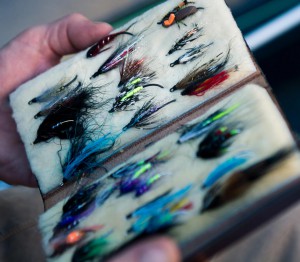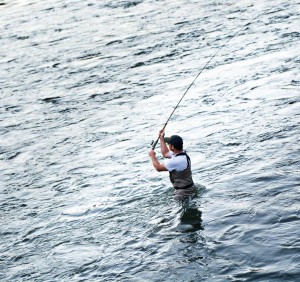By Louis Cahill
Most anglers successfully fish teams of flies for trout. Why not for their anadromous cousins?
I was introduced to this idea by a good friend who is one of the fishiest guys I know. When swinging traditional flies on a floating line he always fishes a team of two flies. He tells me he catches about a third of his fish on the top fly and he’s convinced that it boosts his overall numbers by that amount.
I almost never fish for trout with less than two flies so it’s easy for me to accept the idea that I should be doing it for steelhead. The idea behind tandem flies for swinging is a little different but the logic is compelling. But does it really work?
The Theory
My buddy explained it to me this way. When you are swinging a fly and a fish swirls on it without taking it, what would you do? You’d change flies and make the same cast, showing him another. Sometimes that fish will eat the second fly. My buddy’s idea is that we get looks and swirls all the time that we never see. I find that likely. He ties his second fly the length of his step above the first, so that as he steps he automatically puts two flies over each fish. That’s kind of brilliant.
So to be clear, it’s the fly at the end of the leader which the fish sees first and fly at the top which is seen second. The team functions a little differently than a team of trout flies. A team of trout flies gives the fish a more immediate choice of patterns or depths, covering a spread of what the fish might be keying on. The steelhead version offers the fish a second chance to take the fly, with time being the variable. This makes sense. Steelhead are not feeding so the take is an aggressive strike rather than a reaction to a chosen food type.
The Setup
 First let’s be clear that we are talking about fishing a floating line in traditional summer steelhead fashion. This technique would be extremely difficult to pull off in a Skagit system with sinking tips.
First let’s be clear that we are talking about fishing a floating line in traditional summer steelhead fashion. This technique would be extremely difficult to pull off in a Skagit system with sinking tips.
Like any tandem setup there are several ways you could tie on your flies. For simplicity and function, I like the setup my buddy uses. I use an intermediate polyleader and at the end I attach a short piece of 15-pound Maxima and tie a loop at the end. I then use a loop-to-loop connection to attach my 12-pound maxima tippet. The lengths of leader and tippet vary depending on the line you are fishing and that’s another article.
Rather than tying the fly to this tippet, I slide the line through the front of the upturned eye and slide it up the tippet. I then attach another piece of tippet, the length of my step (3-4 feet), with a blood knot. The first fly will slide back down the tippet and stop at the knot. Surprisingly the fly rides correctly in the water and the blood knot is a very strong stop as the fly does not actually pull against the knot. I then attach the second fly using a turle knot.
Pros and Cons
The pros are simple. As described before, you are showing each fish two different flies on two different casts, in theory covering the water much more effectively. The logic is very appealing. The cons are much the same as in any tandem setup. The opportunity to foul your rig is greatly increased. Fishing this setup, I found that it was less of an issue than I expected. If you make good, clean loops it’s not an issue. If you tail a loop or pile up your leader, you’ll likely have a problem. Spey casting is no different from single-hand casting in that regard.
Because the nature of swinging flies is repetitive, it’s easy to fall into a groove and get sloppy. It’s worth the effort to pay attention to how each loop forms and each cast lands. You should be doing this anyway but it’s especially important with the addition of a second fly.
 You have a longer leader to turn over so good casting technique is important. If that makes you nervous, I encourage you to try it anyway. The only way you learn to turn over a long leader is by fishing with one. The only other downside is that you do have a second hook floating on the leader when the rod is stowed and it will find your hand if you’re not careful.
You have a longer leader to turn over so good casting technique is important. If that makes you nervous, I encourage you to try it anyway. The only way you learn to turn over a long leader is by fishing with one. The only other downside is that you do have a second hook floating on the leader when the rod is stowed and it will find your hand if you’re not careful.
There is always some concern with tandem flies that fish might be foul hooked if they go for the top fly and miss. There are two reasons this is not a problem with this setup. First, if you have the appropriate distance between your flies, there is plenty of room for the fish to swirl and be missed by the lower fly. Secondly, as anyone who swings flies knows, you do not set the hook when a fish takes the fly. There is no jerk to pull the lower fly into the fish. You only come tight to the fish once he turns and runs with the fly firmly in his mouth.
The Field Test
The only way to know if a new technique works is to commit to it. On my recent trip to the Deschutes I used a team of two flies, set up as described for five days, fishing the floating line during the times when there was no sun on the water. I found that it was easier to fish than I had guessed. I did tangle the setup a few times, when it got windy or my cast just broke. When I did, it was not difficult to untangle. It never created a bird’s nest like a trout rig with split shot might.
I caught about half a dozen steelhead on the setup. Here’s the thing, they were all on the bottom fly. Not a single fish on the top fly. I don’t think that means that the technique doesn’t work. There could be a couple of reasons for that result. It could well be pilot error. I fished a smaller fly at the end of the leader and a larger fly above. In retrospect, it might have made more sense to swap them. The fly at the end of the leader was red and the top fly black. It could be that red was the hot color.
It could also be that fly selection and a second opportunity are not as important as finding a fish who is ready to eat. It may well be that, when a steelhead is in the mood, all that matters is putting a well presented fly in front of him and no second opportunity is necessary. A different trip to the river might produce different results, but that’s what I found this time.
Do you swing tandem flies for steelhead?
If so tell us what you’ve experienced in the comments section.
Louis Cahill Gink & Gasoline www.ginkandgasoline.com hookups@ginkandgasoline.com Sign Up For Our Weekly Newsletter!
Sign Up For Our Weekly Newsletter!


Definitely a great technique. Will use the same setup on salmon as well on the east coast, however some of these waters allow for only one free swinging hook. You can use an intruder style or other high attracting tube fly with no hook up top, and a traditional salmon/steelhead fly on the bottom. Seems to provide the same benefits, and still play by the waters rules. Always fun to experiment!
As there are few – if any – absolutes in this great game of chasing steelhead, my experiences agree with, parallel, and diverge from what you relate. THEORY: Based on what I see skating/waking, I agree there are likely many “looks” subsurface we’re not aware of. “Aggressive strikes” covers a lot of country. Although the shoulder-wrenching crushing strikes are by far the most fun, the bulk of the takes I experience vary from little more than a stop to heavy tugs. SETUP: My go-to swing outfit is an 11′ switch rod throwing a SA Integrated Skagit Extreme. That line has a Hi-D sink tip which I sometimes augment with an additional 1′-2′ of T-14. I swing tandems most of the time and really haven’t had any problems doing so. Spey rod friends commonly run tandems off one of the many sink tips they pack along and haven’t mentioned any issues doing so. I usually tie the trailer fly (tied in a loop and often small and dark) off the bend of the first (often large and gaudy) or put the first fly on a very short snell which slides down and jams against a knot as you so describe. This makes it easy to change/remove flies (force the bend knot open or clip off the snell). As you note, most of my fish also take the smaller trailer. My theory (very possibly wrong!) is the large colorful fly catches the fish’s attention and then it works its way up the food chain! FIELD TEST: Although my collection of steelhead flies says otherwise, I’m not really convinced that a particular discrete pattern is very important most of the time. At least in my experience, a “player” (fish ready to eat) trumps just about everything and that fish will most likely take about anything if at the depth and speed it finds agreeable!
Just don’t use this setup in BC, or any other jurisdiction where only one fly is allowed. Always check the regs!
Would be nice to see a picture or drawing of the setup. Kind of hard to visualize for an ancient fly hurler like me….
I think this article would be even better if you added a video to it.